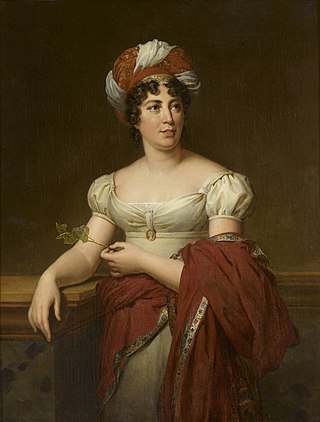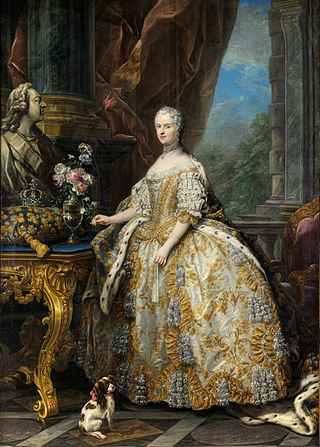
Élisabeth Louise Vigée Le Brun, also known as Louise Élisabeth Vigée Le Brun or simply as Madame Le Brun, was a French painter who mostly specialized in portrait painting, in the late 18th and early 19th centuries.

Jeanne Bécu, Comtesse du Barry was the last maîtresse-en-titre of King Louis XV of France. She was executed by guillotine during the French Revolution on accusations of treason—particularly being suspected of assisting émigrés to flee from the Revolution. She is also known as “Mademoiselle Vaubernier”.

Anne Louise Germaine de Staël-Holstein, commonly known as Madame de Staël, was a prominent philosopher, woman of letters, and political theorist in both Parisian and Genevan intellectual circles. She was the daughter of banker and French finance minister Jacques Necker and Suzanne Curchod, a respected salonhostess. Throughout her life, she held a moderate stance during the tumultuous periods of the French Revolution and the Napoleonic era, persisting until the time of the French Restoration.

Maria Karolina Zofia Felicja Leszczyńska, also known as Marie Leczinska, was Queen of France as the wife of King Louis XV from their marriage on 4 September 1725 until her death in 1768. The daughter of Stanislaus I Leszczyński, the deposed King of Poland, and Catherine Opalińska, her 42-years and 9 months service was the longest of any queen in French history. A devout Catholic throughout her life, Marie was popular among the French people for her numerous charitable works and introduced many Polish customs to the royal court at Versailles. She was the grandmother of the French kings Louis XVI, Louis XVIII and Charles X.

MadameElizabeth Charlotte, Duchess of Orléans, also known as Liselotte von der Pfalz, was a German member of the House of Wittelsbach who married into the French royal family. She was the second wife of Monsieur Philippe I, Duke of Orléans. By Philippe, Liselotte was the mother of Philippe II, Duke of Orléans, and Élisabeth Charlotte, Duchess of Lorraine. Philippe II was France's ruler during the Regency. Liselotte gained literary and historical importance primarily through preservation of her correspondence, which is of great cultural and historical value due to her sometimes very blunt descriptions of French court life and is today one of the best-known German-language texts of the Baroque period.

These Old Shades (1926) is a historical romance written by British novelist Georgette Heyer. The novel is set around 1755: Heyer refers to the Duke of Avon's participation in the 1745 uprising as ten years previous; in addition the Prince of Condé is said to be about 20 years old. However, she also refers to Madame de Pompadour as actively involved with Louis XV, whereas her relationship with the King ended at about 1750.

Élisabeth Philippe Marie Hélène of France, also known as Madame Élisabeth, was a French princess. She was the youngest child of Louis, Dauphin of France, and Duchess Maria Josepha of Saxony, and she was a sister of King Louis XVI. Élisabeth's father, the Dauphin, was the son and heir of King Louis XV and his popular wife, Queen Marie Leszczyńska. Élisabeth remained beside her brother and his family during the French Revolution, and she was executed during the Reign of Terror at the Place de la Révolution. Regarded as a martyr by the Catholic Church, Élisabeth was declared a servant of God by Pope Pius XII.

Marie Adélaïde de France was a French princess, the sixth child and fourth daughter of King Louis XV and Queen Marie Leszczyńska.

Louis-Auguste de Bourbon, duc du Maine was an illegitimate son of Louis XIV and his official mistress, Madame de Montespan. The king's favourite son, he was the founder of the semi-royal House of Bourbon-Maine named after his title and his surname.

A Chinese Ghost Story: The Tsui Hark Animation is a 1997 Hong Kong animated film. It was written and produced by Tsui Hark and his production company, Film Workshop. The animation was produced by Japanese animation studio, Triangle Staff. It is also referred to as "Xiao Qian", "Little Pretty", "Chinese Ghost Story Xiao Qian".
The Duke's Mistress is a Caroline era stage play, a tragicomedy written by James Shirley and first published in 1638. It was the last of Shirley's plays produced before the major break in his career: with the closing of the London theatres due to bubonic plague in May 1636, Shirley left England for Ireland, where he worked under John Ogilby at the Werburgh Street Theatre in Dublin for four years.

A prince du sang or prince of the blood is a person legitimately descended in male line from a sovereign. The female equivalent is princess of the blood, being applied to the daughter of a prince of the blood. The most prominent examples include members of the French royal line, but the term prince of the blood has been used in other families more generally, for example among the British royal family and when referring to the Shinnōke in Japan.

Louise Élisabeth de Bourbon was a daughter of Louis III de Bourbon, Prince of Condé, and his wife, Louise Françoise de Bourbon, légitimée de France, a legitimised daughter of King Louis XIV of France and his famous mistress, Madame de Montespan.
Seneca's Consolations refers to Seneca’s three consolatory works, De Consolatione ad Marciam, De Consolatione ad Polybium, De Consolatione ad Helviam, written around 40–45 AD.

Marie Thérèse Louise of Savoy, Princess de Lamballe was a member of the Savoy-Carignano cadet branch of the House of Savoy. She was married at the age of 17 to Louis Alexandre de Bourbon-Penthièvre, Prince de Lamballe, the heir to the greatest fortune in France. After her marriage, which lasted a year, she went to the French royal court and became the confidante of Queen Marie Antoinette. She was killed in the massacres of September 1792 during the French Revolution.

Scarlet and Black is a British four-part television drama series first aired in 1993 on BBC 1 by the BBC with a cast including Ewan McGregor and Rachel Weisz. The series was adapted by Stephen Lowe from the novel The Red and the Black (1830) by French writer Stendhal. The story follows an ambitious, but impoverished young man, who seduces women of high social standing in order to improve his prospects.

A royal bastard is a child of a reigning monarch born out of wedlock. The king might have a child with a mistress, or the legitimacy of a marriage might be questioned for reasons concerning succession.
E'etemad al-Rumaikiyya was an Andalusian poet, consort of Emir Al-Mu'tamid of Seville. She is believed to have been born between 1045 and 1047.

Caroline Massin was a French seamstress known for her tempestuous marriage with the philosopher Auguste Comte during the most creative period of his life. Comte was mentally unstable and had jealous fantasies about his wife's infidelities. Early in the marriage he broke down and was confined to an asylum for several months. The marriage continued to be strained, with constant money worries. Although Caroline supported her husband and believed in his genius, Comte could never accept her independence. They separated after 17 years. In his last years Comte wrote an appendix to his will in which he accused Caroline of having been a prostitute. The slur was later repeated by his followers. After his death Caroline encouraged a sympathetic biographer of Comte and helped launch a magazine devoted to his philosophy of positivism.

Corinne, or Italy, also known as Corinne, is a novel by the Genevan and French writer Germaine de Staël, published in 1807. It relates a love story between an Italian poet, Corinne, and Lord Oswald Nelvil, an English nobleman. The novel includes both observations and reflections on Italy, its history, its culture and the customs of its inhabitants. Influenced by Enlightenment thought, the novel is part of the French romanticism movement. The novel is Madame de Staël's most famous work, and is the first aesthetic romance not written in German.
















